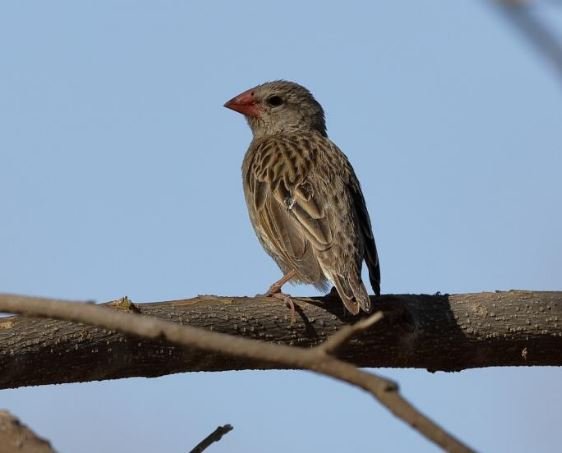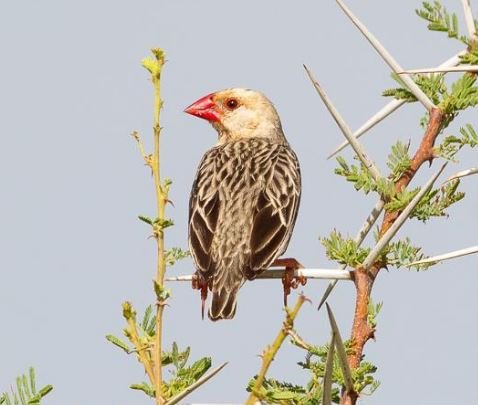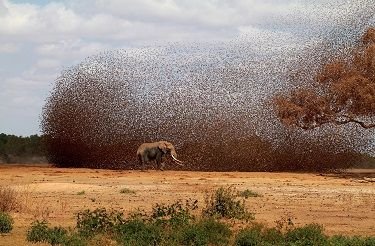Have you ever imagined the sight of a billion bird flying overhead with an estimation of 8 hours to cross?. I bet you will just stand at the amazement of such sight. Though the beauty this specie of bird bring at flying, over here in Africa they are referred to as the worst enemy to humanity, being that they prey on crops for their survival consuming quite an amount due to their numbers. Having a very short incubation period they keep multiplying with time increasing in numbers and in doing so, increase their effect on our plants.
 Source
SourceAre they a mistake nature made to man?
Are they an irony of a gift?
Should We hunt to extinction this species of bird?
Here is the quelea in action
Your thought can be heard the comment section of this article, this is what i have to say on the Red-Billed Quelea
Description Of This Bird
This is a weaver bird which is native to the sub-Saharan region of Africa. Approximately 12 cm in length this bird weighs 15-20 grams. It features a cone shapes bill of which varies in colour ranging from red to orange to yellow. A black facial mask is seen for more than 75% of its population and a black forehead too. This black colour stretch down to its lores, its cheeks and other parts of the throat. The other remaining 25% are bordered by black and are seen to feature a white mask. The white colour goes far down to the lower throat and to the belly and part of its underpart, you will also see a dark stripe at its underpart.On the upper parts, the red-billed quelea features a longitudinal strip which is usually dark brown in colour normally at its mid-length. It has its tail and upper wing colouring dark brown with its edge of flight feathers colouring yellow or greenish.
Coming to its eyes, a red ring and an iris which colours brown can be seen. At legs, we see an orange colour and bill raspberry red.
During non-breading seasons male quelea are known to lack bright colours thus consisting of a grey-brown colour at head with a dark streak, chin and Throat whitish in colour with a stripe above the eyes. For The females during breeding periods, they look just similar to the male but with a yellow or orange colour at the bill but at other times, they have their bill to be pink, sometimes, dull red.
For a Newborn quelea, it has its bill of the colour white and seems almost naked. On the fourth day, they open their eyes to the world, and this is the same period they develop their first wing. The red-billed quelea young bird change its feathers after three months of hatching making them look like a non-breeding adult quelea with a grey hair. About that same period, they have their cheeks whitish, their wings of covert nature with buff margins at their flight feather.
Five months after hatching, they tend to moult again but this time, they now look like a breeding adult with a pinkish purple bill.
Their colour pattern is used when we tend to distinguish their subspecies. For a subspecies, the quelea quelea, breeding males tend to consist of a buff nape and have its black mask stretched up to the forehead. A subspecies known as the quelea aethiopica, its masks are seen to not extend up above the bill and it may have an underpart with pink wash colour. You can vary their subspecies easily but do not put any bird under the quelea subspecies based on outward appearance alone.
Distribution And Habitat Of The Red-Billed Quelea
The Red-billed quelea are in most cases found subtropical areas with a climatic condition semi-arid in nature which usually results to dry thornbush. Their distribution tends to cover most sub-Saharan parts of Africa. They, however, tend to avoid arid areas like west South Africa, Namibia and Angola, and forest like areas.
The red-billed quelea were introduced first in 2000 at the island of Reunion. They are normally seen in areas which are 3,000 meters above the sea level and their residence located 1500 meters above the sea level. Most times they tend to pay to visit agricultural areas to feed on cereal crops but their most prefered meal is the seed of annual wild grass.
For survival they need water they can be found sometimes close to water bodies. When in wet habitats, they are found congregating at shores.
They are well known for their migration as the always migrate in search of their needed resources sometimes over long distances. Their prefered meal develops after weeks of rainfall, thus they tend to migrate to the area after some groups have discovered after search. After feeding, breeding follows which lead to them searching for a suitable breeding place for the next generation, after breeding, another migration takes place.
Behavioural Facts
With the title they got as the most undomesticated bird, Their total post-breeding population is estimated about 1.5 billion with which they feed for their early days on earth, also they need high energy for migration, this makes them find good feeding areas before breeding.
For breeding, they select thorny spiny vegetation. For food search, they fly around each day about 50-65km and return back during the evening to their nest.
The occasionally mix with some other weaver birds, Sudan golden sparrow and some other estrildids. Their lifespan in the wild is about 3 years but they can live about eighteen years when in captivity.
Breeding In Red Billed Quelea Specie
Their breeding process starts with the male making nest for the process. This nest is normally built on thorny trees. A colony of red-billed quelea breeding would consist of millions of nest.
Before the building of the nest, they strip the branches of leaves this fellow by a construction of rings of grass by the male, twining the grass across the branch, this continues till the ring is built.
After building the ring, its now time to attract the female with his displays. After attraction building of the nest will continue. When egg laying starts, working on the nest is done from outside. Due to migration, the red-billed quelea may nest several times in a year.
In a breeding cycle, the male tends to mate with a single female which on a usual base result to 3 eggs. Though sometimes a clutch may consist of more than 3 which is as a result of dumping eggs in a strangers nest. The eggs are light bluish, sometimes greenish and with dark spots.
Incubation of the egg is done by both species as they take turns to incubate the egg during the day and at night, the female alone incubates the egg. This incubation takes only nine to ten days.
Upon hatching of the eggs, chicks are fed with insects which are rich in protein followed by seeds after some days. A young red-billed quelea sexually mature after one year.
Parasites And Predators That Tend To Attack The Red-Billed Quelea
Natural enemies are snakes, mongooses, cats, jackals, squirrels, genets, lions, hyenas, leopards and other birds (the falcon, tawny eagle, marabou stroke and a broad predator know as the siederik which lays eggs on their nest). They are sometimes attacked by snakes which eat their eggs and chicks and also, the Nile crocodiles sometimes tend to attack drinking queleas.
The bush cricket and scorpion are invertebrates which attack and kill young queleas. Internal parasite include the heamoproteus and Plasmodium
Red-Billed Quelea And Humans- Should They Be Extinct?
Here in Africa, they are caught with traps which the triangular hand-held net is most effective in many parts of Africa. An estimate of about 20,000 can be caught each night by a pair of six hunters leading to a total estimate of five to ten million caught each year.
They are referred to as an enemy to man due to their daily consumption of crops planted by farmers. At dry seasons, they feed on wheat and early raining season on rice. A mass of 18g of grain can be consumed by an individual quelea, then you can estimate a million individual consuming about 50t grain in a day
The very large population they come in makes them difficult to control as traditional means like shouting and making noise with tin is used to scare them away which is quite a laborious task. A person can be able to protect about a hectare but they are active from dawn to dusk for more than a month thus calling for quite a task. For large scale farmers, automated methods are used to make them stay away from the farm.
And down to the main question of the day, Are they a pest to be extinct?
From my point of view, i consider them to be a beauty of nature, and rather than enhanced hunting and killing of this bird, we should push our focus to protect our crops from them by scaring them away from the area as they play an important role in the food chain.
What are your thoughts on this bird. Let get down to discussion. I thank the steemstem community for how far they have come to bring the science community in general together. To individuals like @amavi and @justtryme90 for making me better on steeming it. Thanks for reading.
PS: More to come from me so FOLLOW, UPVOTE AND RESTEEM lets make the world a better place, Life is beautiful.
Ref 3





@originalworks
To call @OriginalWorks, simply reply to any post with @originalworks or !originalworks in your message!